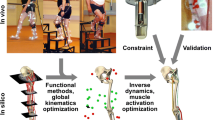Abstract
In the present study, we tested the hypothesis that tension and bending, rather than compression alone, determine the functional adaptation of subchondral bone in incongruous joints. We investigated whether tensile stresses in the subchondral bone of the humero-ulnar articulation are affected by the direction of muscle and joint forces, and whether the tensile stresses are large enough to cause microstructural adaptation, specifically a preferential alignment of the trabeculae and the subchondral collagen fibres. Using a previously validated finite element model of the human humero-ulnar joint, we calculated the contact pressure, the principal compressive and tensile stresses, and the strain energy density in the subchondral bone for various flexion angles. A bicentric (ventro-dorsal) pressure distribution was found in the joint at 30° to 120° of flexion, with contact pressures of up to between 2.5 and 3 MPa in the ventral and dorsal aspects of the ulnar joint surface, but less than 0.5 MPa in the centre. The principal tensile stress in the subchondral bone of the trochlear notch quantitatively exceeded the principal compressive stress at low flexion angles (maximum 8.2 MPa), and the distribution of subchondral strain energy density differed substantially from that of the contact stress (r=–0.72 at 30° and r=+0.58 at 90° of flexion). No important tensile stress was computed in the trochlea humeri. On contact radiography, we found sagittally orientated subarticular trabeculae in the notch, running tangential to the surface. Furthermore, we observed sagittally orientated split lines in the subchondral bone of the notch of 20 cadaver joints, suggesting a ventro-dorsal orientation of the collagen fibres. The trochlea humeri, on the other hand, did not show a preferential direction of the subchondral split lines, these findings confirming the predictions of tensile stresses in the model. We conclude that, due to the important contribution of tension to subchondral bone stress, the distribution of subchondral density cannot be directly employed for assessing the long term distribution of joint pressure at the cartilage surface. The magnitude of the tensional stress varies considerably with the direction of the muscle and joint forces, and it appears large enough to cause functional adaptation of the subchondral bone on a microstructural level.
Similar content being viewed by others
Author information
Authors and Affiliations
Additional information
Accepted: 13 July 1998
Rights and permissions
About this article
Cite this article
Eckstein, F., Merz, B., Schön, M. et al. Tension and bending, but not compression alone determine the functional adaptation of subchondral bone in incongruous joints. Anat Embryol 199, 85–97 (1999). https://doi.org/10.1007/s004290050212
Issue Date:
DOI: https://doi.org/10.1007/s004290050212




